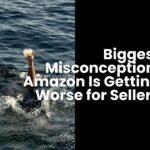Amazon and Chinese tax authorities have closed a long-running loophole that let many China-based sellers avoid paying meaningful income tax on their Amazon sales. As of Q3 2025 reporting, platforms are sending detailed seller revenue and ID data to China’s tax bureau. That means the 20–30% hidden margin some China-based sellers enjoyed is disappearing and the result is a far fairer marketplace for compliant sellers worldwide. At AYS QUEST we call this the end of the tax-free era and the start of a new, professional playing field.
What changed the core facts :
- For years some China-based sellers underreported or hid Amazon revenue, routing money offshore and using shell entities so they paid little or no domestic income tax. That gave them a hidden 20–30% pricing advantage.
- New Chinese rules (issued in 2025) require platforms to report China-based seller data to the Chinese State Taxation Administration. Amazon began reporting that data for Q3 2025 (first report due October 31, 2025).
- The data being reported is comprehensive: seller identity (business registration/tax IDs and national ID), bank account details (including Payoneer and other payout accounts), physical addresses and contact info, store names and URLs, total number of transactions, total revenue, and all commissions and service fees.
- These rules apply to China-based sellers regardless of which Amazon marketplace they sell in even if they only sell into the U.S., that revenue is reported back to China.
- China’s upgraded tax system (Golden Tax System Phase IV) will cross-check platform data with seller filings and automatically trigger audits when numbers don’t match.
- Amazon’s identity verification process (SIV) now ties accounts to real people (national ID + live-video verification), making paper LLC shell games far less effective.
- The first wave of enforcement began with Q3 2025 reporting. This is not hypothetical the data is already in government hands.
Why this matters :
If you’re a compliant seller (U.S., EU, India, etc.), you’ve been at a structural disadvantage. Competitors who didn’t pay taxes could shave 20–30% off price and still be profitable. With that advantage removed, price alone will no longer be the deciding factor in many categories. That forces the marketplace to reward product quality, brand trust, listing strength, service and true operational efficiency — the areas where compliant sellers can and should win.
Who wins and who loses :
- Losers: Small “workshop” operators and mass-listing shops that relied on tax gray zones and offshore routing. Many of the ultra-low-margin, high-volume mass listers will be audited, forced to raise prices, or exit.
- Winners: Compliant exporters and professional brands (those already filing correctly), and international sellers who priced with tax and compliance in mind. As opportunistic price pressure eases, well-run brands gain share.
- Nuance: Not every China-based seller disappears. Bigger, compliant exporters keep competing. Some operators will try re-routing, re-registration, or moving production but identity rules and the Golden Tax cross-checks make simple workarounds much harder.
The bigger policy picture :
- China is tightening tax collection on its export economy to boost compliance and formalize exporters.
- Simultaneously, customs/tariff enforcement (and the end of de-minimis loopholes) reduces import/tariff arbitrage. Together, these moves close the major loopholes that powered extreme price undercutting.
What this means for pricing and competition :
Expect three short-term outcomes in categories crowded with cheap imports:
- Some product listings will disappear (non-compliant sellers forced out).
- Many price-aggressive listings will rise 10–25% as tax liabilities are priced in.
- Market CPCs and bidding dynamics may ease as the “race-to-the-bottom” bidders thin out — but professional competitors will remain and fight on margins, brand and conversion.
AYS QUEST’s strategic playbook how to win now :
This is a once-in-several-years competitive reset. Here’s how to capitalize, broken into immediate, short, and medium term moves focused on Listings and Amazon Ads (your priorities).
Immediate (first 30 days)
- Audit your categories: Identify SKUs where the competition was absurdly cheap. Those are the vacuum opportunities.
- Recalculate your margin room: With the likely exit or repricing of non-compliant sellers, you can be more aggressive on bids for high-margin SKUs. Recompute break-even points with the new dynamic in mind.
- Negate the bloodsuckers: Start surgical PPC negations — block irrelevant/cheap traffic terms that burn budget. This immediately improves ACoS.
- Protect supply: If you expect a spike in demand, secure inventory now. Winning share when competitors vanish requires stock.
Short term (1–3 months)
- Hunt the SEO vacuum: Monitor keywords whose top results belonged to suppliers that drop out. Capture those terms with optimized listings and targeted campaigns.
- Shift to TACoS (not vanity ACoS): Focus on total advertising cost of sale to ensure ads are boosting organic rank and long-term profitability.
- Attack with precision PPC: Turn defensive ad spends into offensive spend. Reallocate budget from low-ROI SKUs into your high-margin winners and keywords that are newly cheaper to win.
- Improve listings fast: Convert more traffic — fix images, rewrite bullets for benefit-driven copy, add the best converting search terms to backend fields, and deploy A+ content where possible.
Medium term (3–12 months)
- Build a storefront moat: Use Sponsored Brands and Storefronts to create a curated destination for shoppers. Keep customers inside your ecosystem, not on commodity listing pages.
- Invest in brand trust: Use A+ content and your brand story to make price less important. Comparison charts, social proof and clear US/brand signals matter.
- Systemize PPC>SEO loop: Capture converting PPC search terms, drive them into listings, and watch organic rank and TACoS improve. Repeat.
- Plan for pro-competition: Expect a smaller, smarter set of Chinese brands to double down — you’ll now be fighting professional players. Your advantage: trust, supply chain agility, faster service and compliance.
Tactical moves that actually move the needle (examples)
- Mosquito repellent for ad spend: Negate obviously irrelevant search terms (e.g., “free,” “cheap,” or other low-intent terms) dramatic ACoS improvements often follow in days.
- Protect winners, kill losers: Stop subsidizing low-margin SKUs with ad budgets. Double budgets on ASINs with healthy margins and conversion rates.
- A+ + comparison charts: Use A+ to cross-sell and reduce churn; comparison tables keep buyers on your page and increase basket size.
- Leverage Storefronts for Sponsored Brands funnels: Route sponsored brand traffic to your Storefront to reduce on-page competition and increase lifetime value.
Common questions :
- Will sellers just move to Vietnam or Mexico? Moving production or registrations is not an instant fix. If a company is still China-based for tax purposes or identity, it will be caught by the new reporting and cross-checks. Some companies will shift production, but identity and tax rules are getting tighter.
- Is this only a US story? No this affects any marketplace where China-based sellers sold. Reporting is to Chinese tax authorities and applies regardless of the Amazon store (US, UK, EU, etc.).
- Will prices spike everywhere? Not everywhere, and not uniformly. Expect the biggest effects where cash-play, low-margin imports dominated (electronics accessories, cheap home goods, novelty items).
Final, blunt advice from AYS QUEST :
This regulatory change is a competitive reset — not an excuse. The era where you blamed invisible, tax-free undercutters is ending. The new battlefield rewards sellers who are professional: data-driven on PPC, obsessive about listing conversion, and disciplined about inventory and pricing.
If you want to act like a winner:
- Fix listings first ads without conversion are wasted money.
- Recalibrate PPC to attack high-margin winners, not defend dead SKUs.
- Use the SEO vacuum to grab organic keywords left by departing sellers.
- Build your brand story in A+ and Storefront to convert and retain customers.
AYS QUEST is already implementing these plays for clients not as theory, but as repeatable frameworks. If you want a tactical one-page checklist or a prioritized action plan for your catalog, we’ll prepare a tailored playbook for you that maps directly to your profit targets and inventory reality.
The playing field is finally level. Don’t wait professionalize and take the market.





